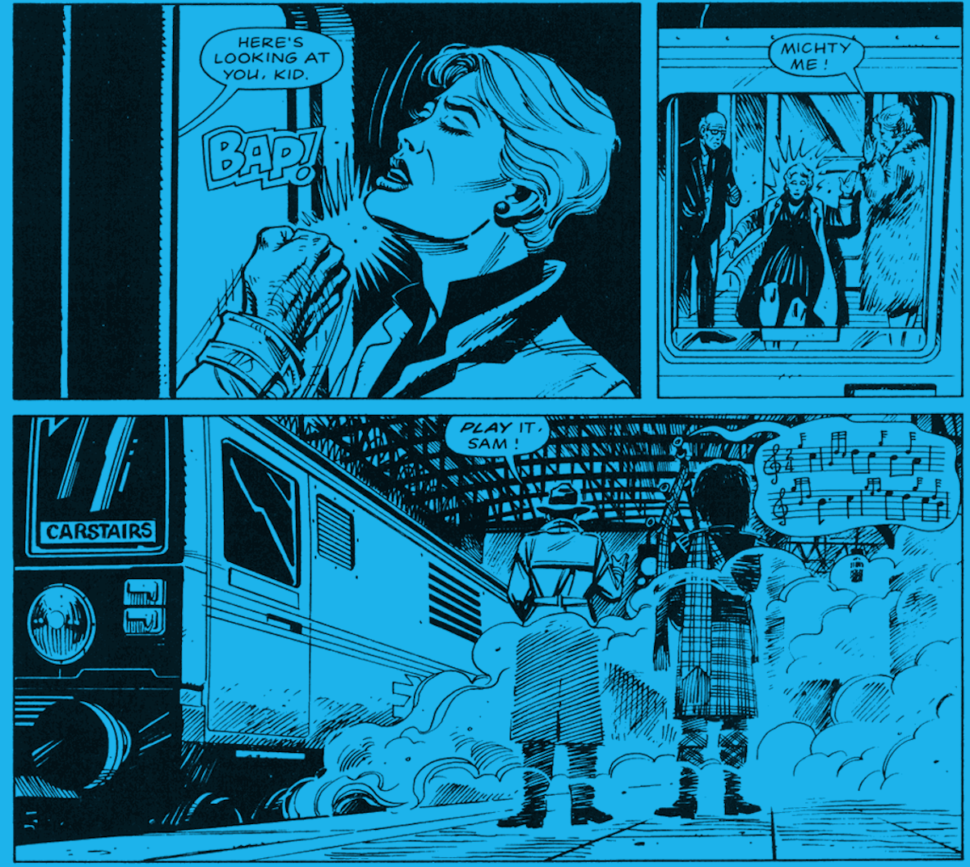Eagle-eyed readers of 2000 AD’s December 2022 Alan Grant tribute strip by Gordon Rennie and one-time art editor Robin Smith might have noticed a subtle nod to one of Grant and Wagner’s lesser-known works, seemingly long-forgotten among the constant comics churn over the years. But the Bogie Man, which is set to receive a new printing and whose picture appeared among a bundle of old Grant works in the strip, is one of Wagner and Grant’s very best and one of their most fondly-remembered in the West of Scotland at least.
For many of us who grew up in the 1980s from that part of the world (this writer included), the four issues of the original Bogie Man are inextricably linked to 1990 and Glasgow’s year as European City of Culture; a time of optimism in a city tarnished by its post-industrial landscape, dreich skies and unwanted reputation for drinking and fighting. As hard as it might seem now to believe, this 32-page, black and white, US-format comic – the sole publication of the short-lived Fat Man Press – was available to buy in high-street stores, eventually becoming the UK’s biggest-selling independent comic.. ever. Sequels and a network television film followed in the space of a few short years.
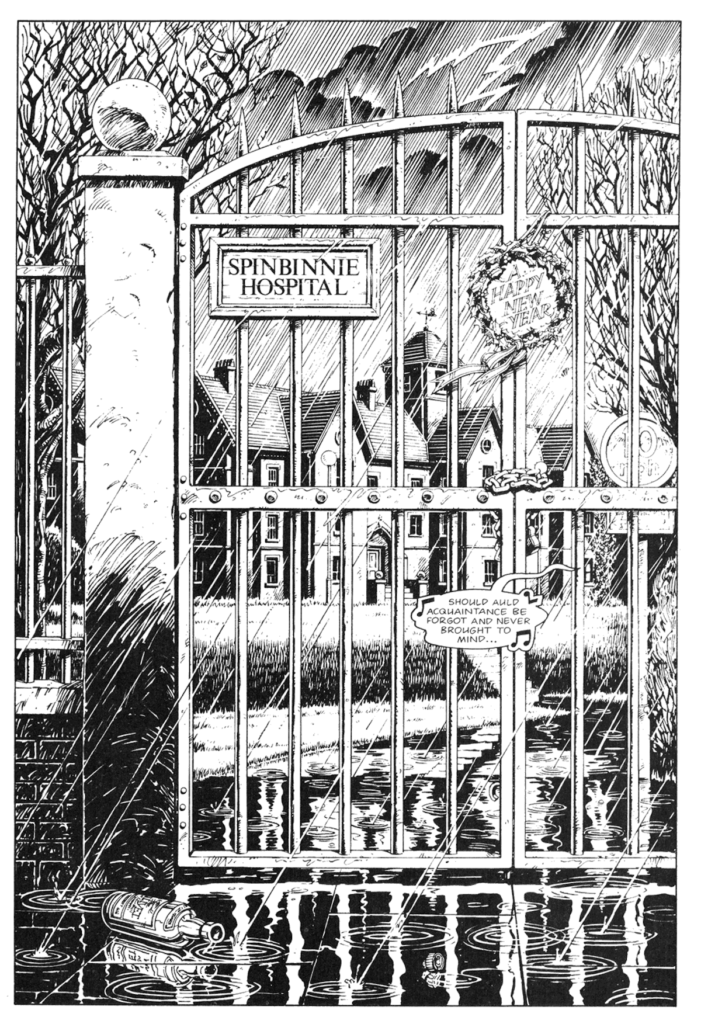
All of this preamble is surely doing the Bogie Man a disservice. It was – and still is – hilarious. A free flowing farce, the Bogie Man follows the misadventures of a lunatic asylum escapee named Francis Forbes Clunie who “suffers” from the surely-unique delusion that he is a Philip Marlowe-era Humphrey Bogart (as a bonus he looks the part). The plot throws Clunie – or more accurately Bogie – into a boiling pot of Glaswegian crime, boozing, mistaken identities, cops, small-time gangsters, and – to be frank – idiots. At risk of giving my age away, I laughed like a drain at this one in my late teens and still do. But perhaps the funniest section of all was an end-of-comic glossary for non-Scots readers that appeared in every issue, featuring memorable translations, such as: “ferrit face” for “someone about to be struck”; and “galoot” for “stupid fellow”.
Although theoretically targeted towards readers less familiar with the Scots – or Glaswegian – form of English, one of the Bogie Man’s two surviving creators, John Wagner, believes most could probably have worked out the meaning easily enough without the assistance of the “handy glossary”.
“I don’t know if we’ll print a glossary in the collection we’re planning to bring out later this year – we probably will, just for the fun of it,” he says, speaking ahead of the projected Kickstarter campaign for a new collection. “I can’t imagine the Bogie Man without the glossary,” says fellow creator Robin Smith. “It’s possibly my favourite part.”
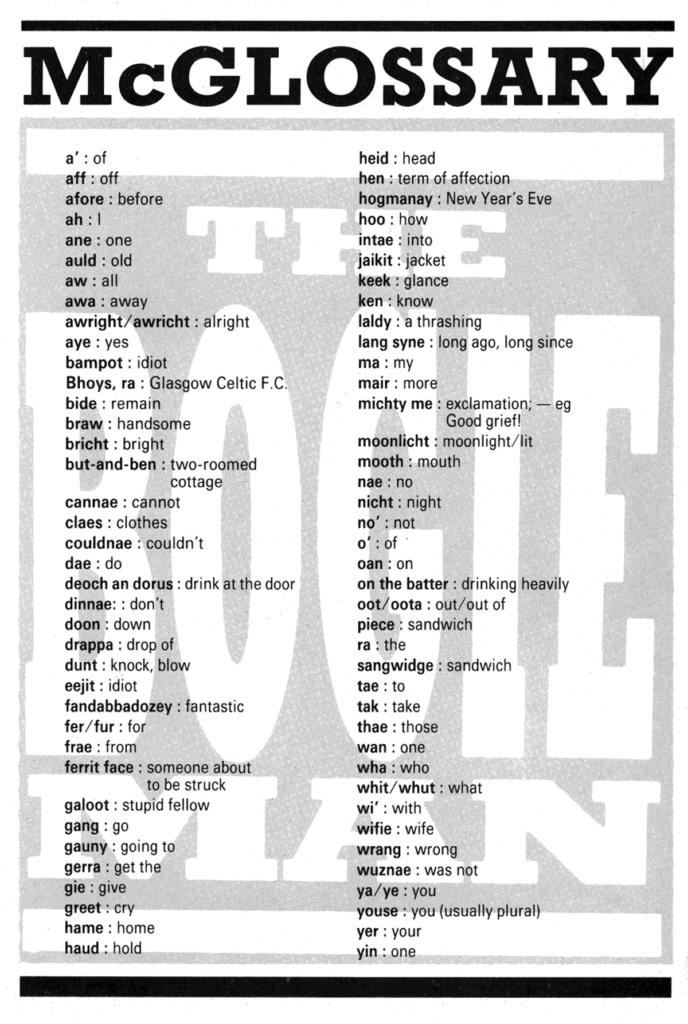
As Wagner recalls, the idea for the Bogie Man first came about in an Eagle comic story (“not the original Eagle but the 1980s version”) where Grant and Wagner were in full-flow, pumping out superbly-written gems such as Doomlord and Manix (a conflicted alien “judges” Earth and essentially an alternative version of 2000AD’s M.A.C.H. 1) to the less well-remembered Fists of Danny Pyke. But if there was one thing the early 80s Eagle was known for, it was the prevalence of photo strips: awkwardly staged stills of actors (some later better known) leading the readers through the action, which enjoyed huge popularity during the era. One such photostrip was Joe Soap, a farce about an incompetent private detective written by Wagner and Grant. Sounds familiar? Well it was here that the saga of the Bogie Man effectively began.
“The editor, Dave Hunt, let us know they had access to an actor who looked like Humphrey Bogart, and asked if we could use him,” says Wagner. “We came up with the idea of a nutcase who thought he was Bogart or similar detectives of the era.”
Smith was aware of the character even at this early stage having collaborated with Wagner and Grant on a couple of Eagle strips following his departure from the 2000 AD editorial team. “They were doing their version of what they thought Humphrey Bogart sounds like,” he laughs. “They loved it and John would go off on a Bogart thing all the time.”
The story never appeared as Eagle stopped doing photo strips, but Grant and Wagner filed the idea away as being “too good to forget” in the hope of finding an interested publisher.
And try they did. The duo pitched “Bogie” – as he came to be known – to DC Comics, but were rapidly rejected. “It was pretty much the same character but set in the US – San Francisco or some such place, can’t remember,” remembers Wagner. “DC Comics, to whom we pitched the idea, thought there was no audience for such a story.”
Somewhat ironically, the series (or more accurately, Bogie’s first two adventures) would return to DC years later under its short-lived Paradox Press imprint with a Bogie collection in 1998. Unfortunately, one of the casualties of Bogie’s return to North America was the Scottish dialect that arguably made the strip so unique, of which more later.
The original Bogie finally found a home with Fat Man Press, a small independent set-up by John McShane, co-owner of Glasgow’s long-standing ninth-art institution AKA Books & Comics.
“John always had a fancy for being a publisher,” says Wagner. “It was Robin who suggested we do Bogie for him (and his friend and business partner George Jackson), set in Glasgow. The idea appealed very much to Alan and me, both having grown up in Scotland.”
A native of Port Sunlight, close to Liverpool, Smith would make regular trips to Glasgow with fellow 2000 AD creators to guest at comics marts organized by McShane and his retail store partners.
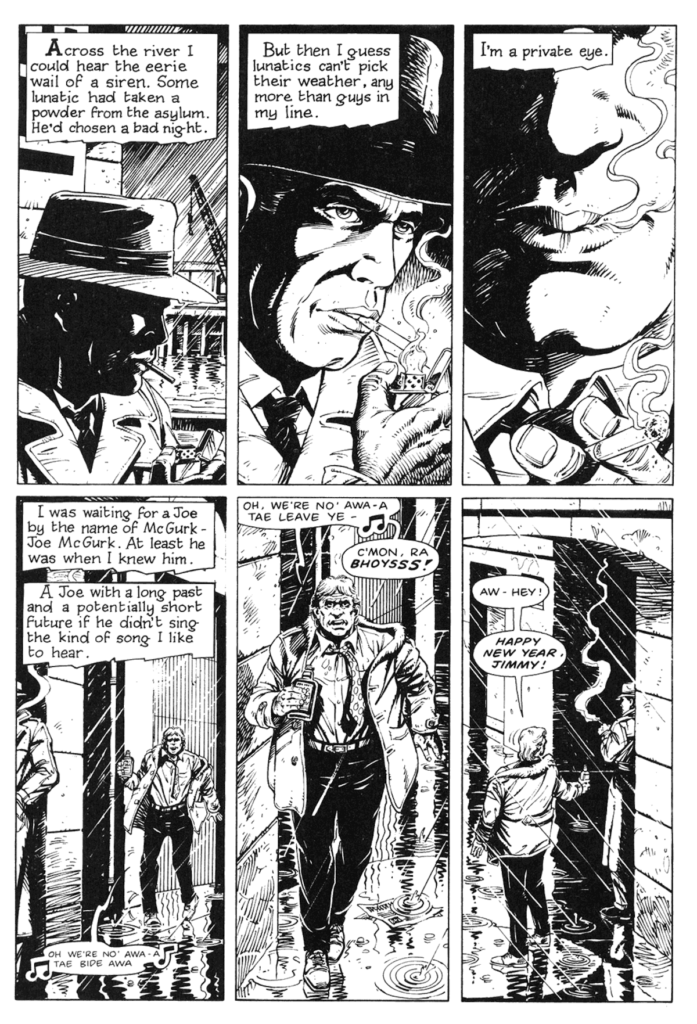
“I wanted to draw Glasgow and I remember sitting with John McShane and drinking late into the night and talking through the idea of doing a crumbling, futuristic version of the city, but it didn’t really come to anything,” he recalls.
“John and Alan still wanted a home for their Bogart story and I knew they wanted to do something Scottish as well. You used to get all sorts of bits of Scottish stuff in Judge Dredd stories like Fergie (from “The Day the Law Died” saga) who was based on one of John’s friends from Scotland, so I knew they always wanted to write Scottish stuff. I suggested we set it in Glasgow, and it was absolutely perfect.”
In true entrepreneurial spirit, McShane and Jackson viewed Glasgow’s stint as European City of Culture as a promotional opportunity, according to Smith, who says the idea was to explicitly market the comic as a tie-in. In contrast, Wagner remembers the timing as more of a “happy coincidence”, which gave impetus to the project, although he gives publishers full credit for placing it with mainstream retailers. “John and George did do a really good job of publicising the comic and getting it into shops,” he says.
In keeping with its setting, the Bogie Man was notable for being peppered with Scots-flavored humor, whose inspiration was very much drawn from Wagner and Grant’s own experiences. Although Wagner admits the dialogue could be a little “Oor Wullie” at times –referencing a Scots kid’s comic serialised in Scotland’s Sunday Post newspaper since 1936– but this, he says, just added to the fun.
But perhaps even more than a “humor” comic, Wagner views the Bogie Man as the writers’ homage to Scotland, or at the least the Scotland where they both grew up, Wagner in the port of Greenock to the west of Glasgow and Grant in Newtongrange south of Edinburgh. It was also the first story Wagner had written for anyone other than large publishers, which he recalls as a refreshing change.
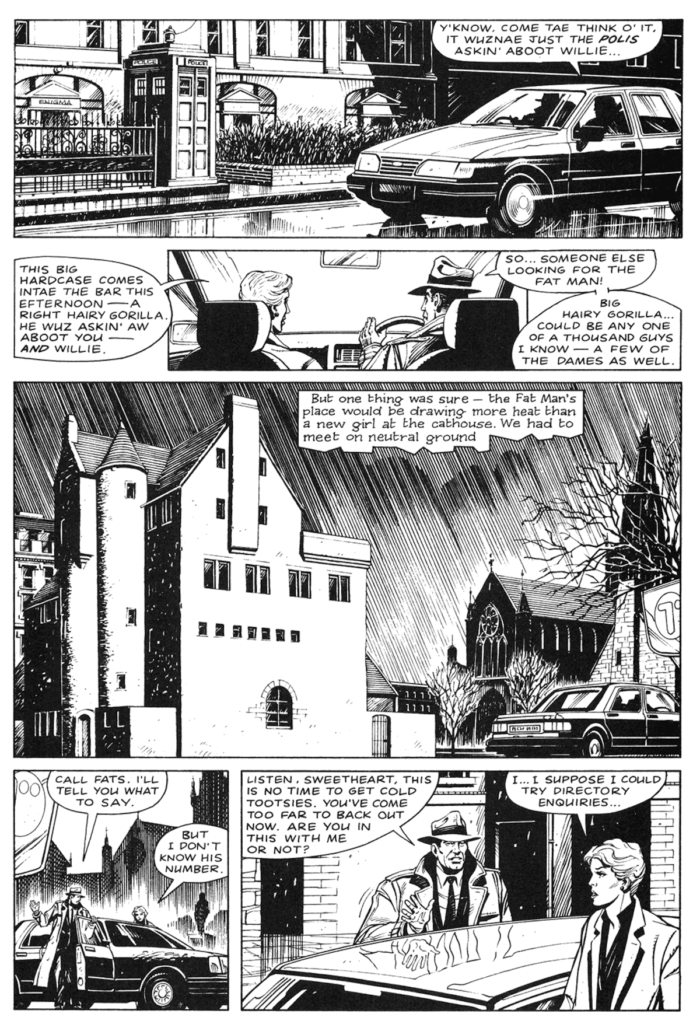
“It felt much more personal and indeed remains – along perhaps with the Rok saga – the story I am fondest of,” he reveals. “Using Glasgow heavily as a setting was an important part of the strong Scottish flavor we wanted to impart.”
To bring the setting to life, the creators sourced as much reference material as they could and even asked McShane to go to the Necropolis – the city’s iconic Victorian cemetery that featured in 2022’s The Batman – and take a bunch of photos for use in the story’s big showdown.
“I can’t remember if he nipped over the wall or arranged to be let in,” Wagner says. For “Spinbinnie”, Bogie’s asylum, Wagner sent his sister on a photo-reference scouting mission to Greenock’s now-shuttered Ravenscraig Hospital. “It was in Greenock near where my mother lived and had always struck me as a rather sinister, forbidding place – just right for the story,” says Wagner. “Robin caught the city really well in the art, which was a big plus.”
While Smith himself provided much of the required reference material from photos or architecture volumes, McShane and Jackson mapped out many of the series’ action sequences.
“I told them what I wanted to see and they very kindly got me all of the photos I needed,” Smith recalls. “So when there’s a car chase in Glasgow, they walked the route of it. I also made a point of putting [Glasgow’s oldest surviving restaurant] Rogano in there because everyone wanted a free meal, and things like that looked great.”
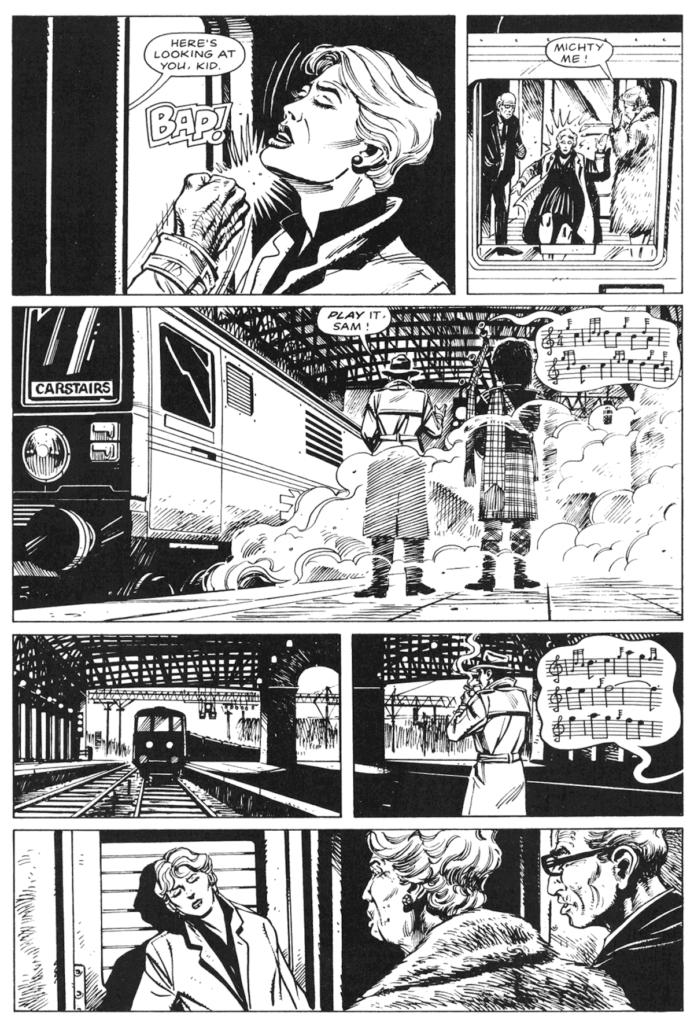
However, the references didn’t stop there. In the Bogie Man’s final scene, the deluded Clunie bundles a female bartender onto a train in a farcical nod to Casablanca’s final scene as a lone piper plays. “If you can read music, that should be the melody to “As Times Goes By”,” says Smith. “George Jackson got a piper to transpose it for me.”
Later on, when Smith needed a reference for a “Clyde steamer” ship, Wagner’s mother sent him a postcard with the required image. “Everyone chipped in,” Smith recalls. The home-made feel of the Bogie Man even extended to Smith designing the Fat Man Press logo himself and overseeing production of the issues with a Glasgow-based printer.
One episode Smith and Wagner look back less fondly on is the 1992 BBC adaptation of the Bogie Man. Starring Scots superstar – and future-Hagrid – Robbie Coltrane, the one-off film, directed by Charles Gormley and scripted by Paul Pender, aired on December 29 of the same year.
“It looked fantastic, like they’d art-directed it from the comic, but unfortunately they changed the script and suggested (Bogie) had been doing it on purpose, which missed the point really,” says Smith.
Wagner is even less forgiving. “They fucked it up,” he says bluntly. “It could have been great and we were so looking forward to it, what a letdown it was.
“For a start the screenwriter decided to impose himself all over the story, jumbled the whole thing up till it made very little sense and went a long way to destroying the humour.”
One the plus side, Wagner says the cast was excellent, with the co-writers both initially delighted that Robbie Coltrane (“an actor we liked a lot”) signed to play Bogie. Unfortunately, Wagner believes Coltrane didn’t understand the story. “He played the part tongue-in-cheek, like Bogie knew he was a loon, and that’s not his character,” he argues. “Bogie believes in his mad fantasies 100%, he’s deadly serious about it all, prepared to kill if necessary (and even if not).”
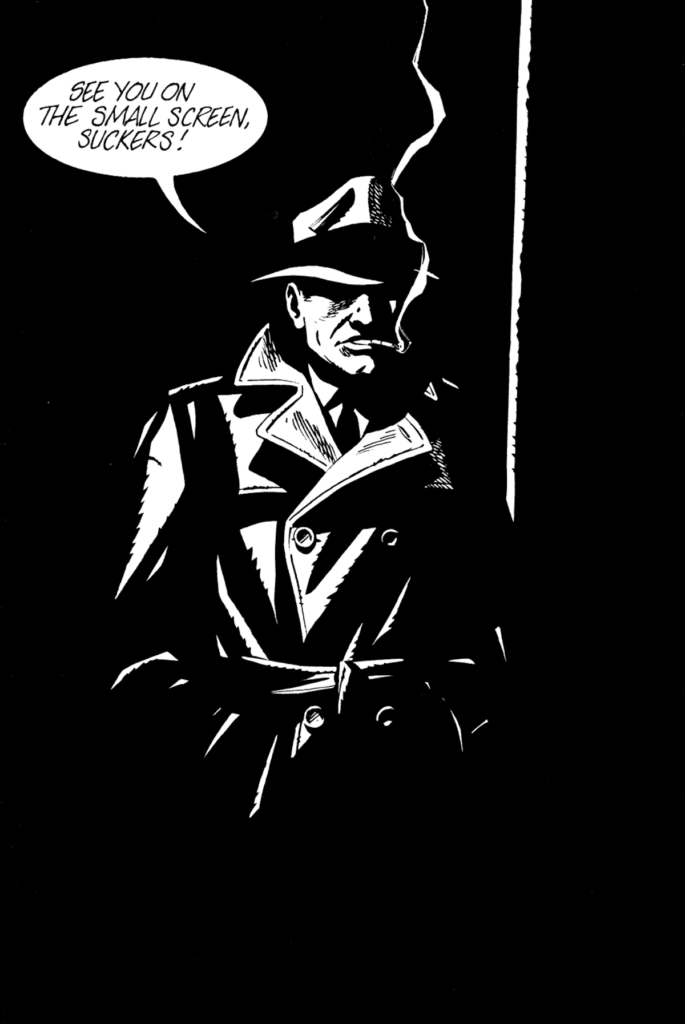
The film was broadcast – just once – at Christmas on BBC2, opposite the then recently-released Gorillas in The Mist on BBC1, and fared poorly. “Not that many people saw it, and that’s probably a good thing,” says Wagner. “You can still see it on YouTube, but I’d save yourself the trouble. Just read the books.”
In the years following the original Fat Man Press series and the failed BBC adaptation, the Bogie Man appeared to become a comic strip in search of a home, landing first at short-lived 2000 AD rival Toxic!, Dave Elliot and Garry Leach’s Atomeka Press, Kevin Eastman’s Tundra and even Simon & Schuster before eventually arriving at the Judge Dredd Megazine for one final adventure. As well as the usual Scotland-based shenanigans, these later stories included a trip to the US (The Manhattan Project) and a somewhat improbable meeting with former US vice-president Dan Quayle.
But perhaps the most controversial period of the Bogie Man’s wandering years was Wagner and Grant’s decision to replace Smith with Can Kennedy for the follow up to the first Bogie story, “Chinatoon”. Although Smith was eventually brought back to redraw the story in its entirety, the episode soured relations between the creators with long-term consequences.
“There’s nothing I’m proud of about that part of the Bogie Man saga,” concedes Wagner.
“We agreed to run “Chinatoon” in Toxic!, a new comic meant to rival 2000 AD, and brought Cam Kennedy in on the art. I won’t go into the many reasons for the change but it was a mistake. It wasn’t fair to Cam to put him in that position and it most certainly wasn’t fair to Robin, who had done such a bang-up job on the first story.
“I’m not sure why Cam never finished “Chinatoon” – possibly it was the demise of Toxic!. But that’s the thing about The Bogie Man, it may have brought that about, because there seemed to be curse on it.”
“I think what sums it up perfectly is one word: Toxic,” says Smith. “You don’t need any more than that.”
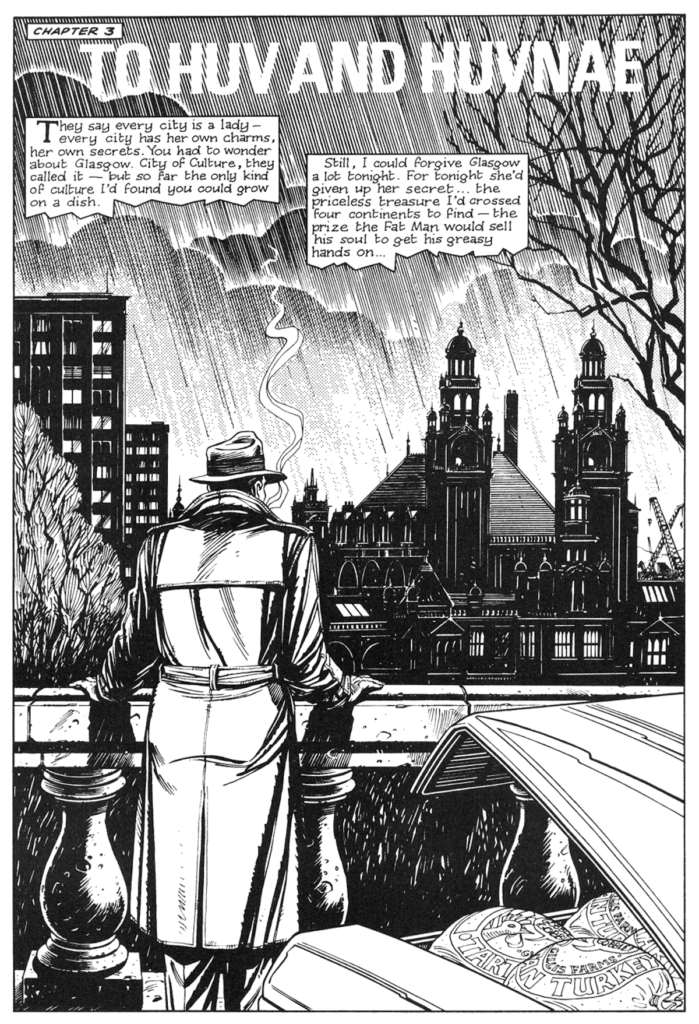
For Wagner, everything Bogie touched seemed to turn to dust. McShane and Jackson were nearly bankrupted despite the Bogie Man being the UK’s highest selling independent comic. The creators “never saw a penny in royalties” and received very little money from the TV film as the bank swallowed up the final cheque from the BBC.
“I don’t get the impression that anyone ever set-out to stop us getting money on purpose,” Smith believes. “Things just happened. Even when Kevin Eastman republished “Chinatoon” at Tundra, we didn’t make anything out of it.”
For Wagner, the TV production that the creators had such great hopes for was dire and destroyed any prospect of further films. George Jackson also passed away shortly afterwards at a relatively young age.
“The rift with Robin – admittedly our fault, not Bogie’s (but don’t doubt he had a hand in it!) – went a long way toward destroying our friendship,” Wagner continues. “In the end we started calling it ‘The Scottish Comic’ to ward off further bad luck.”
Any yet, Wagner says, the three creators still love – and loved – it. “It was the best thing Alan and I wrote together, and the story I’m proudest of,” he adds.
To date, the creators still own full copyright to all the Bogie stores and plan to finally bring them back into print in a new collection to debut later in 2023 via Kickstarter. With a projected total of 280 pages of strip, the book will include three black-and-white Bogie Man stories and funding is expected to launch in May.
The collection will include the first story – just called “The Bogie Man” – “Chinatoon” and “Return to Casablanca”, the third saga, set in Edinburgh. Wagner says the creators decided against including The Manhattan Project as its in color and “more than a little dated”.
“Fortunately, I’ve got every page of artwork,” says Smith. “It went off to America to be published by DC, but there was no film of it by that time because everyone who had published it had thrown the film away. So I had to send the artwork to DC who did it at a reduced, paperback size.”
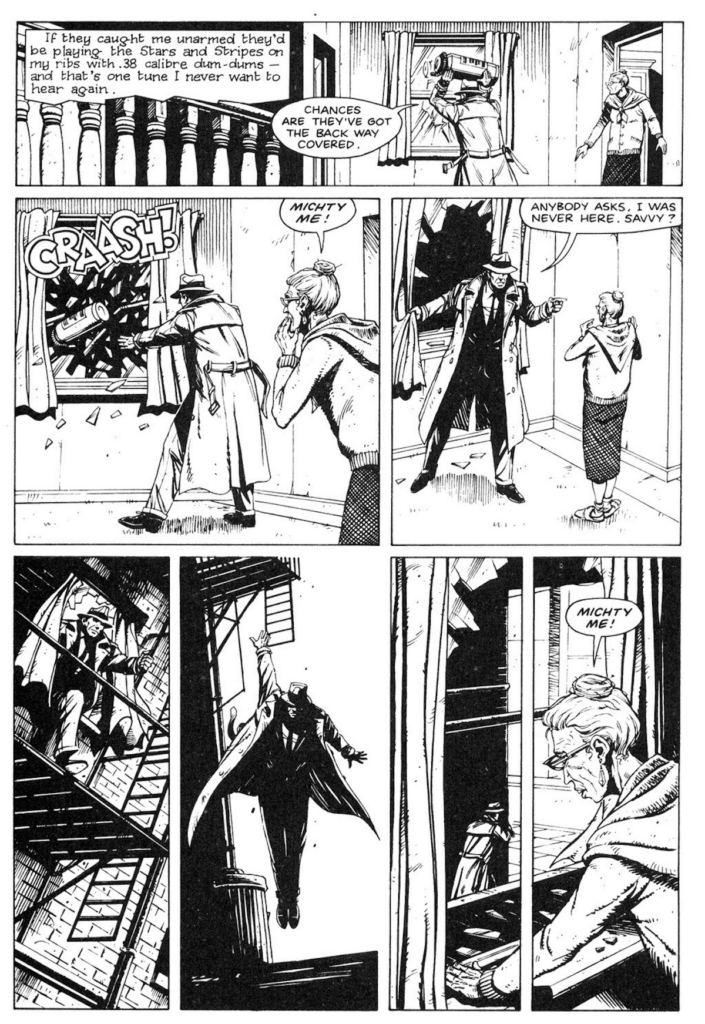
As well as having to rescan the artwork, production of the new edition has included the recreation of the original dialogue after DC editors replaced substantial sections with standard English.
“John and I are quite enthusiastic about doing this and Alan was up for it before he died,” says Smith. “I’ve already spotted a lot of instances where they changed dialogue and I’m also sending copies to John who has been going through it with a highlighter pen.”
As with almost every artist who looks back on old artwork, Smith says there are parts he loves and others that he would love to rework, but concedes such preferences are invariably personal. “All I can say is I like all of the writing and some of the artwork,” he laughs. “I would say “Chinatoon” is my favourite story – of course it’s got nothing to do with Chinatown, but it’s perfect Bogie Man.”
“Chinatoon” was, by a hair, my favourite of the first two books,” agrees Wagner. “I was initially reluctant to reprint the third story, “Return to Casablanca”, as I felt it was inferior to the first two, until I read it again in conjunction with them.
“It brings back a lot of the characters from the first two books – like (comical heavies) the McCurdie brothers, Inspector Douglas Douglas and Rab McNab of Fab Dab Ceilidh Band fame (characters inspired by my summer spell working on the Clyde steamers) – and with that fresh in the mind it all makes sense and is actually extremely funny. It had me laughing anyway.”
“Everyone loved the Bogie Man,” adds Smith. “It was a Scottish comic for Scotland and it was the funniest thing John and Alan had written. It just doesn’t explain why it never made any money.”
